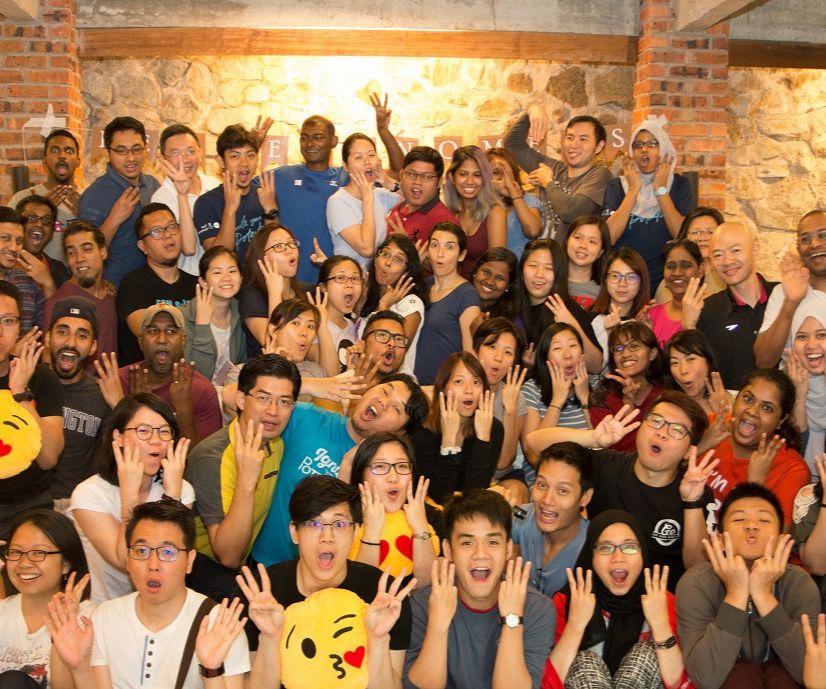Drivers Of Engagement

 Photo credit (above): 드림포유 | Flickr
Photo credit (above): 드림포유 | Flickr
The Malaysian chapter
We had the opportunity to connect with Aon Hewitt on the topic of drivers of engagement with a particular focus on trends in Malaysia.
In this interview, we hear from Jeremy Andrulis, CEO, Southeast Asia, Prashant Chadha, managing director, Malaysia, Dr. Jens Ballendowitsch, talent practice leader, and Ji-Hao Lee, senior consultant.
Q1 What are the top four drivers of engagement in Malaysia?
1. Career opportunities (50%)
2. Recognition (41%)
3. Brand alignment (46%)
4. Pay (40%)
The key improvement factors for engagement remain stable across time. (See TABLE 1 below)
Q2 What are your observations for certain demographic groups in Malaysia, e.g. Gen-Y vs Gen-X, women vs men, graduates vs non-graduates?
Gen-Y employees are seeking more meaningful tasks in the workplace. Brand alignment and benefits are in the top six drivers for Gen-Y, highlighting their interest in working in organisations that deliver on their promises and those that offer competitive benefits.
For female employees, pay and benefits rank third and fourth, with work tasks also included among their top six. In planning strategies to increase female engagement, organisations in Malaysia should take note of these.
Especially in terms of benefits, engagement of this gender group can be improved. These findings are very close to the reality faced by female workers in Malaysian (child care, family support, etc.)
Junior management displays the same six drivers to improve engagement as the market average. However, recognition is ranked first, instead of career opportunities, as in the other demographic groups.
To improve engagement levels among junior managers, programmes that focus on recognition in the workplace should be considered.
Also, recognising and acknowledging behaviour of people managers – in short, leadership skills – is key in this respect.
Ji-Hao Lee, senior consultant:
As the ‘Say, Stay and Strive’ engagement behaviours are outcomes, these behaviours cannot be simply forced onto every employee, especially in a diverse workforce.
This is because what drives each employee to say, stay or strive can be very different between individuals and demographic groups.
Through the Best Employers programme, we are able to see that while the top drivers remain relatively consistent, there are unique drivers that are important to improve engagement for different groups of employees.
Focusing effort and resources on specific drivers for specific target groups will bring the best ROI (return on investment) in terms of creating a more engaged workforce. (See TABLE 2 below)
Q3 Would you like to share practical tips or best practices with employers seeking to improve employee engagement in a disparate workforce?
To improve employee engagement in the workforce, the key to success is for companies to select and promote the right managers, then engage and develop them.
Dr. Jens Ballendowitsch, talent practice leader:
People managers are central in translating the employment deal offered to employees to their respective teams.
Beyond pay, this involves career opportunities, recognition and in how far the organisation delivers on the promises it makes to its employees.
Companies need to ensure that all people managers are aligned and consistent in terms of the organisation’s value proposition and its communication to employees (new joiners and current staff).
Jeremy Andrulis, CEO, Southeast Asia:
Organisations can enable people managers to be more effective by providing them with more options and flexibility to respond to the different needs of employees (i.e. flexibility in a framework).
For example, organisations can identify a few ‘rewards’ or ‘development’ options that are delegated to managers to apply (e.g. flexible start times, two hours of personal time off per month, special recognition bonus above the standard amount, budget to attend external seminars or courses).
Critical to the success of flexible schemes is to communicate to managers on how to apply these programmes and to communicate to employees on why they are being implemented.
Prashant Chadha, managing director, Malaysia:
Diversity is actually a strength which can sometimes be ignored. It is important to play to your strengths.
Here are general steps to start engaging your people.
Step 1: Simplify − Segment your workforce to better understand differences by age, work type, etc.
Step 2: Strength in numbers − Form a group of volunteers within the business to be the spokespeople for engagement.
Step 3: Knowledge − Impact analysis helps to narrow in on a focus area(s). Alternatively, if you manage surveys internally, you could also conduct a few focus groups to get direction in conjunction with the survey results.
Step 4: Focus − Pick two focus areas for the year and approach the exercise as one team. Remember engagement isn’t just an HR (human resources) exercise; it’s a business requirement.
Research has demonstrated that engaged employees are more aligned to business results and the success of the organisation.
Step 5: Communicate − Communicate, update, celebrate!
Q4 Have you analysed how Gen-X and millennials in Malaysia may differ from those of other countries, and how placing people in these categories may benefit, or be a disservice to both employee and employer?
Prashant:
Generational diversity isn’t really different in most countries. Since the internet boom, the virtual gateways aided similarities across borders.
That being said, it’s imperative to understand the differences across the generations. Segmentation is the first step to understand and appreciate what’s important to our employees.
Data by segment often presents perceived engagement drivers that vary depending on the employees’ generation and years of service within the organisation. Even the same driver may mean different things across generations.
Ballendowitsch:
While generational opinions and engagement differences are not unique to Malaysia, the growing segment in Malaysia’s workforce (in line with many other developing countries) mainly comprises of Gen-Ys.
Hence, managing this particular group which is a majority in Malaysia becomes very important.
Organisations that fail to address the needs of this group will most likely not succeed in engaging their employees.
Q5 We welcome any advice you have for employers, or more specifically HR professionals as they seek to become strategic partners in their organisations.
Andrulis:
It starts with having a deep understanding of the revenue, cost and risk drivers for your company, the competitive landscape for your company, the industry trends, and the long term business strategy/model.
The next step would be to ‘think backwards’ from the strategic goals and revenue/cost/risk drivers and develop insights and programmes for the people and organisation areas that most impact the revenue/cost/risk drivers.
Organisations should communicate in the language of business – start with the goals or value drivers (revenue/cost/risk) and present your people programmes as solutions to business problems.
Companies should also hire people into HR from the business – and build HR capabilities in analytics, influencing/networking and problem-solving.
Prashant:
If HR were to realign one thing then our advice would be to ensure alignment with business strategy. HR strategy and operations must have business strategy/aspirations linked outcome focus.
This ensures buy-in from leaders (same goal), employees (linkage to expectations) and HR teams (contributing to business results).
This is an important step in the maturity cycle of organisations and will need the support of leadership teams to make this a reality!
Ji-Hao:
In addition to the above, there is also much learning from Best Employers.
The recent Best Employers Malaysia study, which examined 25,000 employee responses and survey data from CEOs and HR directors, highlights that organisations that invest in engagement register higher revenue growth than the rest of the market in the long run.
What emerged from our study as the most noticeable benefits of being a Best Employer in Malaysia in today’s “war for talent” were the following:
- As Best Employers, the role of senior leaders in driving employee engagement was clearly marked. Senior leaders scored 20% above market in their “capability to provide a clear direction for the future” (recognised by 81% of the employees at Best Employers vs 60% market average) and “in making their employees feel like the most valued assets” (76% for Best Employers vs 55% market average).
- Best Employers were able to fill 90% of their job openings, 25% of which were internal movements, (as compared to 77% and 20%, respectively at market level), thus reflecting potential savings in recruitment and induction costs.
- Best Employers have been more deliberate in enabling employee development beyond the classroom setting via “experiential learning” – rotational assignments (100% of Best Employers vs 51% participant average), special projects (88% of Best Employers vs 55% participant average), and interactions with senior executives (88% of Best Employers vs 49% participant average), leading to overall employee satisfaction with growth opportunities (being 24% higher at Best Employers).
While engaging Gen-Y is a key focus for organisations today, Best Employers have an edge, with a 21% higher engagement score for Gen-Y compared to the market.
Best Employers are reaping benefits from their focus on targeted programmes designed to align with various demographic groups. Becoming a Best Employer is a journey, and it doesn’t happen overnight.
Different organisations are at different stages of this journey, and it is important to know where your organisation stands today so you can chart and measure your progress.
To measure and improve employee engagement, the Aon Hewitt Best Employers Malaysia 2015 programme provides a platform to identify engagement levels, leadership effectiveness, employer brand and culture to drive high performance.
Best practices in talent management are shared with participating organisations and results are benchmarked against other aspiring or recognised Best Employers in Malaysia and Asia.
Originally published in The Star’s MyStarJob pullout on 4 October, 2014.
To find out more about Aon Hewitt Best Employers Malaysia 2015, email editor@leaderonomics.com. To learn more about engagement initiatives for your organisation, email people@leaderonomics.com to find out about the Leaderonomics Center for Engagement Excellence (LCEE)
Functional










